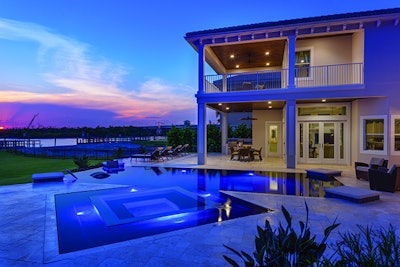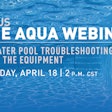
Although pools with water spilling over an edge have been built for decades, the concept is still new to many homeowners and even some builders. And where there are novel building concepts there is the possibility of calamity.
Such calamity can take the form of angry, vengeful customers and actual litigation. Lew Akins has seen plenty of it. As a 35-year veteran of the business with experience in different kinds of pool construction, he serves as an expert witness in pool building lawsuits around the country — many of them involving vanishing-edge construction. As a relatively new type of construction, Akins says, vanishing edges have seen more than their share of legal action.
Akins is president of Ocean Quest Pools by Lew Akins in Belton, Texas, and has authored many articles and seminars on vanishing-edge construction. His insights into what has gone wrong focus attention on the trouble spots and can help builders avoid similar mistakes.
Communicate With A Purpose
The No. 1 cause of disaster in the construction of a vanishing-edge pool, according to Akins, is poor communication. It's simple, it costs nothing, and yet it remains the root source of ultimate failure.
"A lot of times there's a simple absence of understanding from homeowners of what to expect from a vanishing-edge pool," Akins says. "Either that or the things they do expect are just wrong."
This is because the technology remains unfamiliar to the general public. Most people have an understanding of the basic workings of a standard 16-by-24-foot fiberglass pool, but the workings of a vanishing-edge pool are new to them.
"The problem is usually that the guy that sold it hasn't really explained up front the ramifications of buying a vanishing-edge pool," he says.
One issue in particular comes up again and again with new vanishing-edge pool owners — an apparent leak in the catch pool.
"They think that they have a leak because the level of water in the catch pool drops a certain distance on a daily basis. But that's simply the fact that the evaporative loss in the main pool is reflected in the catch pool."
In a standard pool, evaporative loss is reflected in the slight lowering of its water level. But the water level in a vanishing-edge pool remains constant; losses there are concentrated in the catch pool, which is used to refill it and keep its level constant.
So water losses in the catch pool reflect evaporation not only from its own surface, but the surface of the main pool, as well.
What makes the effect more dramatic is the smaller surface area of the catch pool. If the area of the main pool is 500 square feet and it loses a volume of water that would normally make its level drop 1 inch, the apparent loss of water in its catch pool of 50 square feet (a tenth of the main pool's area) will be 10 times as great, or 10 inches — a shocking amount in a short time.
"And there's nothing wrong," says Akins, "but the customer perceives that there is something wrong, and that becomes a sticky point for the builder because he hasn't explained it. And explaining it after the fact doesn't have nearly the credibility of telling the client ahead of time."
The problem is exacerbated if the catch pool is too small for the pool it supports, adds Spencer White, owner, Cascade Pools, Lake Oswego, Ore., another veteran of vanishing-edge construction.
Cascade Pools builds catch pools with automatic fills that maintain the water level and skimmers to keep heavy debris from finding its way into the plumbing. But that won't help if the catch pool is just too small for the job.
"If you don't have the right ratio of surface area between the pool and the catch tank," White says, "when you turn your effects pump on — the pump that runs the negative-edge flow — the water level in the catch tank falls below the level of the skimmers, and that causes a problem."
The Weir Wall
Another trouble spot is the weir wall, which, unlike the side of a standard pool, has water in contact on both sides.
Akins asserts that a builder cannot count on a plaster surface to waterproof the weir wall, but must use a waterproofing product on the concrete wall before it's plastered. And on both sides.
"You really have to waterproof both sides of the weir," he says, "understanding that there are different waterproofing products for the positive side and negative side, and you must use products that are specific to the side you are waterproofing.
"Some products waterproof the positive (pool) side, and some waterproof the other (negative) side. Some even work on both sides, but most will not, so it's critically important that the label instructions be followed to the letter."
In any case, without a good seal on the concrete, water will work its way down into it, and degradation of the weir wall will follow — rapidly if it has not been formed properly.
A forming method that is particularly at fault, Akins says, is the tying of pegboard directly to the steel. "That does not allow for a full complement of concrete around the steel, which creates potential water penetrations and compromises the strength of the wall. It's just a bad construction practice, period.
"And if you're not forming from the ground up, you need to make sure you have dobies in place to hold the form off the steel so you can get a good complement of steel around it."
Akins has seen the same construction problem in raised spas, often from inexperienced builders, he says, "and they end up with the same exact issues."
Depending on the climate, surface waterproofing on the weir can also be a trouble spot, says White: "If water is able to penetrate the veneer or tile, when a freeze hits, that water expands and sometimes it will pop the tile up, or whatever the veneer happens to be.
"We haven't had too much of a problem with that until this year; it's been a long time since we had weather like this in Oregon. Most of the surface finishes are tile, and you've got water running over that edge most of the time, and it soaks up moisture."
Any damage or disfiguring of the weir edge will have a noticeable effect on the look of the feature, of course. Building and maintaining that edge within a tight tolerance is essential to building an energy-efficient pool. That's because the smaller the total variation in edge height, the smaller the amount of water that is needed to produce the desired negative-edge effect.
"You don't need much," says Akins. "If you are level at the edge, you can keep it full and flowing with hardly any water. You can literally create flow across a negative edge with a garden hose.
"That's a fairly common mistake guys make when they're guessing. They don't know for sure, and they want to cover their asses, so they put a great big pump on it. That's because they're worried about not being level at the edge, and they feel they may need more flow to make up for that. Of course, it adds a significant amount of cost to the job upfront, and also to the operation of the pool.
"If you're suspect of your ability to hit a tight tolerance across the edge, you can use a building material that you can modify in the field."
Check Valves
A final, but no less important trouble spot is the plumbing between the catch pool and the main pool, through which water is pumped to keep fluid spilling over the edge and back into the catch pool.
Since the catch pool is located below the main pool, when that pump is switched off, nature would like to drain all the water from the main pool down into the catch pool. A check valve in the line prevents this; unless it fails.
"That's not pretty when that happens," says Akins. "All the water drains out of the pool, and it floods down below and into the neighbor's yard, and they are usually just delighted with that."
Everything fails eventually, so it's essential to have a vacuum breaker built into the system as a backup to prevent equalization of the water level when, inevitably, check valves fail, too.
Most of these problems tend to occur when a builder tries to guess at the solution of a building challenge, Akins says.
"Guessing is such bad form when it comes to vanishing-edge pools, I can't begin to tell you. I used to see a lot of that, but I don't see as much of it anymore. There aren't nearly as many nightmares as there used to be," he says.








































